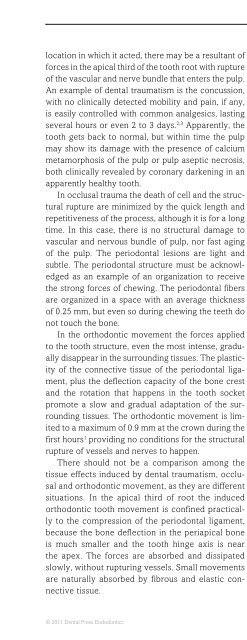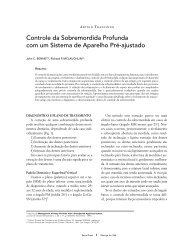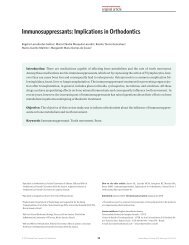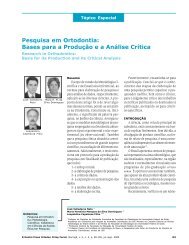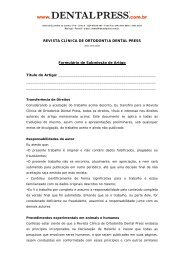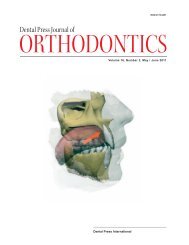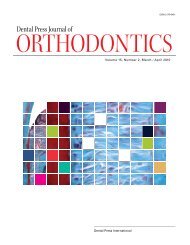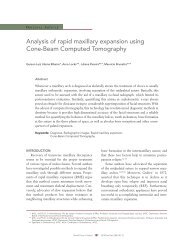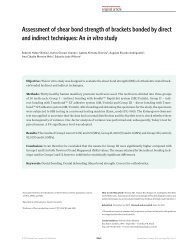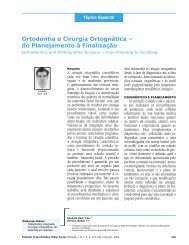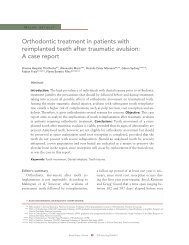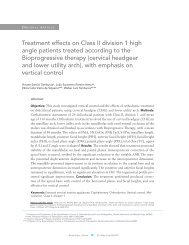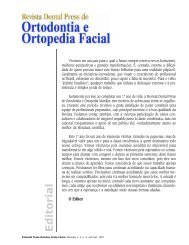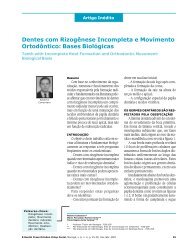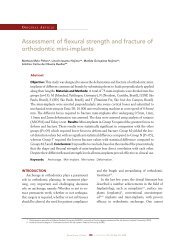Dental Press
Dental Press
Dental Press
You also want an ePaper? Increase the reach of your titles
YUMPU automatically turns print PDFs into web optimized ePapers that Google loves.
[ original article ] Effect of intracanal posts on dimensions of cone beam computed tomography images of endodontically treated teethThe teeth were randomly allocated into 5 groupsaccording to the intracanal post material: Group 1 (n =9) - Pre-fabricated Glass-Fiber Post ® (White post DC ® ,FGM, Joinville, SC, Brazil); Group 2 (n = 9) - Pre-fabricatedCarbon Fiber Root Canal ® (Reforpost CarbonFiber RX, Angelus, Londrina, PR, Brazil); Group 3 (n =9) - Pre-fabricated Post – Metal Screws ® (ObturationScrews ® , FKG, Dentaire, La Chaux-de-Founds, Swiss);Group 4 (n = 9) – Silver Alloy Post ® (Silver Alloy laCroix ® , Rio de Janeiro, RJ, Brazil); Group 5 (n = 9)– Gold Alloy Post ® (Gold Alloy Stabilor G ® , Au-58.0,Pd-5.5, Ag-23.3, Cu-12.0, Zn trace, Ir trace; DeguDentBenelux BV, Hoorn, Netherlands). It was consideredas control the original specimen of each group.After root canal preparation was completed, allteeth were filled with AH PlusTM (Dentsply/Maillefer)and gutta-percha points, and prepared accordingto the manufacturer’s instructions and using aconventional lateral condensation technique. The diametersof the prefabricated posts used in Groups 1to 3 were compatible with the diameter of preparedroot canals. For Groups 4 and 5, silver and gold metalposts were fabricated after obtaining impressions ofthe root canals.The gutta-percha filling was removed and an intracanalpost space was prepared using Gates-Gliddendrills #2 to #3 (Dentsply/Maillefer) and Largodrill #1 (Dentsply/Maillefer) to achieve a post lengthof 8 mm and to leave at least 4 mm of filling materialin the apical third (Fig 1). The post cementationmaterial used was resin cement (RelyX Unicem,3M ESPE, Seefeld, Germany) strictly according tomanufacturer´s instructions.Images AnalysisCBCT scans were acquired to obtain 3D images.The teeth were placed on a plastic platform positionedin the center of a bucket filled with water tosimulate soft tissue, according to a model describedin previous studies. 18,26,28 CBCT images were acquiredwith a first generation i-CAT Cone Beam 3D imagingsystem (Imaging Sciences International, Hatfield, PA,USA). The volumes were reconstructed 0.2 mm isometricvoxels. The tube voltage was 120 kVp and thetube current, 3.8 mA. Exposure time was 40 seconds.Images were examined with the scanner’s proprietarysoftware (Xoran version 3.1.62; Xoran Technologies,Ann Arbor, MI, USA) in a PC workstation runningMicrosoft Windows XP professional SP-2 (MicrosoftCorp, Redmond, WA, USA) with an Intel ® Core 2Duo-6300 1.86 Ghz processor (Intel Corporation,USA), NVIDIA GeForce 6200 turbo cache videocard(NVIDIA Corporation, USA) and an EIZO - FlexscanS2000 monitor at 1600x1200 pixels resolution (EizoNanao Corporation Hakusan, Japan).Root sectioningAfter obtaining the CBCT scans, each specimenwas carefully sectioned in axial, sagittal or coronalplanes using an Endo Z bur (Dentsply/Maillefer) athigh speed rotation under water-spray cooling. Thecross-sectional slices for the axial plane were obtainedat 8 mm from the root apex; and for sagittaland coronal planes, the roots were sectioned longitudinallyalong the center of the root canal (Fig 1).Measurement of specimens and CBCT slicesThe CBCT scans of intracanal posts (ICP) weremeasured in the axial, sagittal or coronal planes. Allmeasurements were made at 8 mm from the rootapex (Fig 1). ICP measurements on axial slices weremade in the buccolingual direction; on sagittal slices,in the mesiodistal direction; and on coronal slices, inthe buccolingual direction. All teeth were measuredby two endodontic specialists using a 0.01-mm resolutiondigital caliper (Fowler/Sylvac Ultra-cal Mark IVEletronic Caliper, Crissier, Switzerland).To determine the discrepancy between originalICP values and CBCT values, all measurements weremade on the same axial, sagittal and coronal sites. Allthe CBCT measurements were acquired by two dentalradiology specialists using the measuring tool ofthe CBCT proprietary software (Xoran version 3.1.62;Xoran Technologies, Ann Arbor, MI, USA). CBCT dimensionswere reformatted using 0.2-, 0.6-, 1.0-, 3.0-and 5.0-mm slice thicknesses.The two calibrated examiners measured all thespecimens and CBCT images and evaluated ICPdimensions in the directions previously described.When a consensus was not reached, a third observermade the final decision.One-way analysis of variance (ANOVA), Tukeyand Kruskall-Wallis tests were used for statisticalanalyses. The level of significance was set at α = 5%.© 2011 <strong>Dental</strong> <strong>Press</strong> Endodontics 30<strong>Dental</strong> <strong>Press</strong> Endod. 2011 apr-june;1(1):28-36


